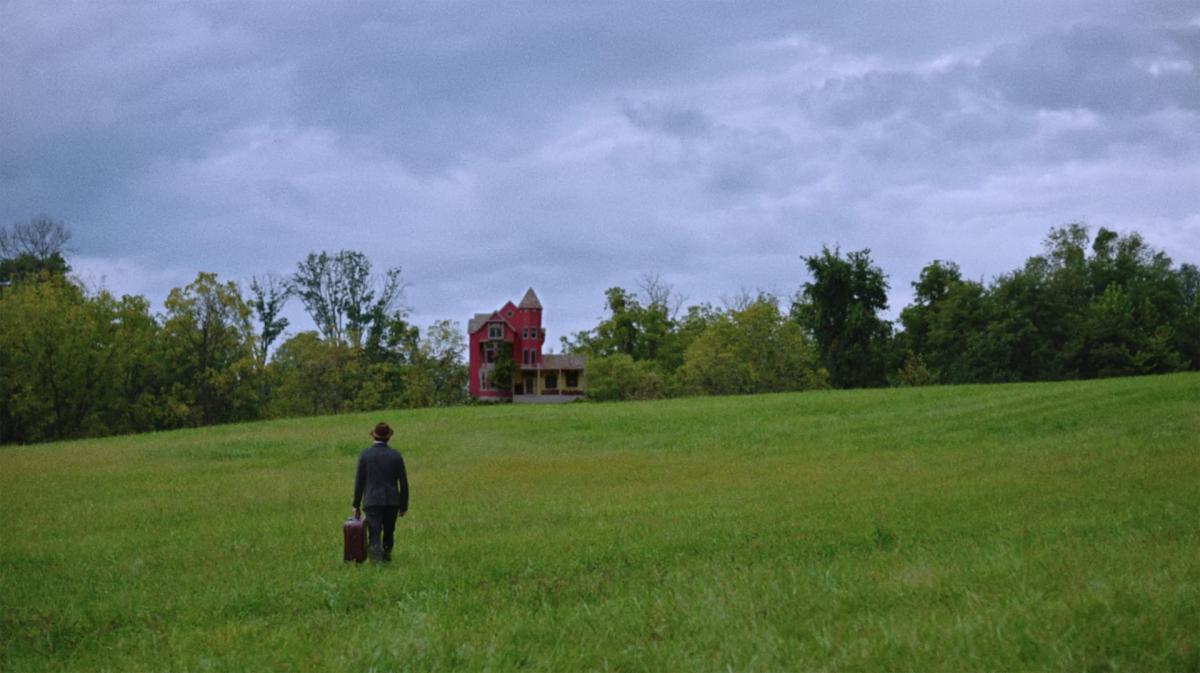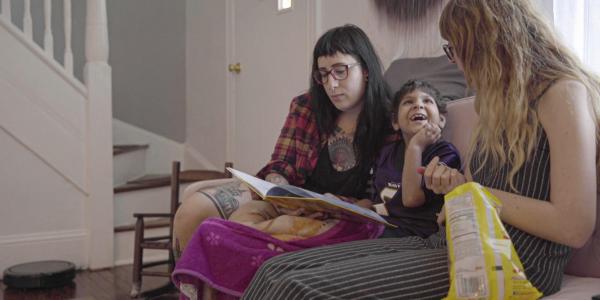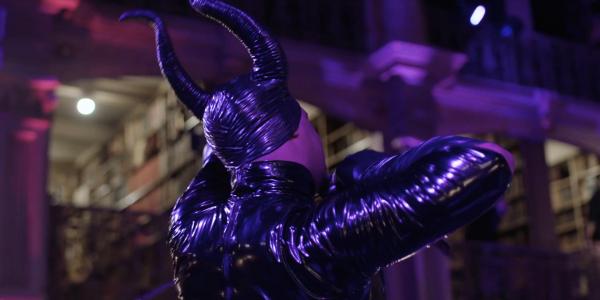
Sometimes film festivals can be a little daunting. So many films, often overlapping. The hottest tickets can lead to hours in line, only to be greeted at the box office with “No Soup for You!” That’s the beauty of this year’s Maryland Film Festival, which is once again (mostly) virtual, and is now extended to nine days, May 19-27. If you’re truly committed, as festival director Sandra Gibson told us, you can actually watch all the films and shorts, on your own schedule. That said, there’s lots of scheduled panels, parties, and even a drive-in screening at Druid Hill Park, hosted by John Waters. Be sure to check out their website for the complete schedule and how best to fest.
To get you started, here are reviews of four wonderful, locally-made films.
STRAWBERRY MANSION
As Strawberry Mansion starts, our hero, James Preble (co-director and co-writer Kentucker Audley), is trapped in a small, Pepto-Bismol pink room. On top of being that sickly color, everything is coated in a claymation-like substance.
There is no food or water. It becomes menacing. Then a cheerful man—a beer-bellied best friend in a sitcom type—knocks on the door, bearing a bottle of Red Robin soda and a bucket of Cap’n Kelly chicken. “Buddy!” Preble says, happy to see his friend, and he begins to chow down.
In the morning, Preble wakes up and logs his dream into an automated system. Turns out, this is a not-so-distant future where dreams are recorded, stored, and audited. And Preble is not just your garden variety dreamer, he’s a dream auditor himself. After stopping at Cap’n Kelly for a bucket with extra gravy (he’s suddenly craving chicken), his job takes him to the isolated home of an artist and eccentric, Arabella Isadora (Penny Fuller), who hasn’t paid her dream taxes in years. What’s more, she hasn’t digitized her dreams, the way most people have, but has them stored on something akin to VHS tapes. There are thousands of hours of tape. Arabella offers to put up Preble in a guest room—he’ll be sharing it with her pet turtle.
Horror film tropes being as they are, we suspect that the cheerful, chatty, slightly daffy Arabella might secretly be dangerous. But she’s not. In fact, she’s just a kind-hearted, lonely person in need of a friend. She’s also in possession of a disturbing truth about dream auditing that will change the way Preble views his job (and reality).
Preble puts a fancy viewing contraption on his head—the bulky metal box would be the idea of something futuristic in a 1950s sci-fi film—that allows him to enter Arabella’s dreams. In the dreams, she’s an ethereal young woman (Grace Glowicki), prone to hanging out in meadows and hugging tree-shaped men, and he is immediately smitten by her. (Technically, we don’t appear in our own dreams so Preble wouldn’t be able to see young Arabella, but since he doesn’t just view the dreams, he enters them, I’ll allow it.)
The film alternates between dream and reality, as events transpire that put Preble’s life in danger. It’s an acid trip of a movie, with talking frogs and rats and flies and scary sea creatures, but it has an internal logic and a deadpan sense of humor that makes it quite accessible. And of course, at its heart, it’s a love story.
Fans of Charlie Kaufman will surely delight in this film, which was shot in Baltimore and co-written and directed by Baltimore’s own Albert Birney. Strawberry Mansions forever, y’all.
[Strawberry Mansion is the opening night film of the MdFF, May 19]

ALL LIGHT, EVERYWHERE
Baltimore-based documentarian Theo Anthony is part sociologist, part poet, part philosopher—a combination which results in some fascinating and provocative films. His first documentary feature, Rat Film, was about Baltimore’s rat infestation. But it was equally about human nature, how we conform and adapt to our environments, and how, well, rat-like we all really are. His second documentary, All Light, Everywhere, which features another hypnotic and spacy soundtrack by local maestro Dan Deacon, is about the dangers of our surveillance state. But it’s equally about the way we see things, our desire for some kind of universal truth, and the limitations of consciousness.
As has become his trademark, Anthony threads together several narratives—often inserting himself in the action, just so we’re clear that this is his perspective, and that his presence as an observer inherently changes things. There’s also a placid-sounding female narrator who adds crucial bits of facts and historical context.
For part of the film, we’re getting a tour of the Axon headquarters, led by Steve Tuttle, a cheerful and slick PR guy. Axon makes body cameras that are used by the police as well as tasers, which is remarkable—but less so when the narrator explains that the first movie camera operated a bit like an automatic rifle, with a rotating chamber that clicked pictures. (The metaphor may be thick, but it also bears the advantage of being true.)
I’m always amazed when a person goes on film and incriminates themselves—but that’s sort of what happens to Tuttle here.
Leading the tour, Tuttle remarks that he’s proud of Axon’s open space and policy of transparency. The company is all about “candor with a positive intent,” he says, more than once (whatever the hell that means). Then the tour leads to an atrium of sorts, with blackened windows. This is where the top-secret stuff happens, Tuttle says with a grin, seemingly not noticing that he’s just contradicted himself.
Anthony also takes us inside a police training class where a group of cops are learning to use the body camera. The class is taught from the perspective that body cameras protect police officers, not citizens. Suspects lie about cops, the instructor explains, but the body camera can exonerate them. But, of course, what the body cam sees is not truth, Anthony reminds us. It’s one solitary perspective—that of the cop (indeed, that of one limited plain of vision of the cop—much as they try to give a panoramic view, there are blind spots in the bodycams). “There’s always a body behind the body camera,” the narrator notes. At one point, the film explains that cops are actually allowed to view the body camera footage before coming up with their official account of what happened.
One of the most fascinating sequences takes places inside a community town hall in West Baltimore. Ross McNutt, the owner of Persistent Surveillance System (hey, points for truth in advertising), is trying to sell the notion of his surveillance planes to the neighborhood. He has local “influencers” of sorts set up at the town hall, arguing that the planes will deter crime.
“Can the community watch the footage?” one resident smartly asks. McNutt looks briefly chagrined—no, the footage is strictly to be seen by law enforcement, he admits.
Again and again, the documentary has us questioning what we see and what we think we see—the very notion of a shared truth. It’s all happening already, of course. Mass surveillance. Deep fake photography that can literally trick the eye. Weapons created by the same companies that make cameras.
But, as one citizen at that town hall noted, “Just because we’re already being surveilled, why should we always be surveilled?”
[All Light, Everywhere debuts May 23]

MOM & M
Documentaries don’t get much more intimate than Mom & M. The film is a portrait of an extraordinary Baltimore family: Nikki and Elise and their adopted daughter Sansa. Oftentimes a documentary takes place after the fact, giving both the audience and the main players a chance to process the events and reflect on the big picture. Jen Burchick’s Mom & M is a little different. It just kind of plunks into the story in medias res, as it were—making it all the more compelling. Sansa, a bundle of energy and charm, has just finished her last treatment for leukemia and is starting kindergarten for the first time. Her parents worry about her illness returning, and, of course, they worry about how she will fit in at school. On top of Sansa’s illness, she also has developmental issues—her fine motor skills are a little underdeveloped and she almost definitely has ADHD. Nonetheless, her spirit is so happy and infectiously joyful, it’s easy to be patient with her (usually).
As for the transgender Nikki, she’s only recently transitioned, and both she and Elise are still coming to terms what that means for their marriage. They don’t really have time to discuss their relationship, because they’re just so busy existing: Dealing with financial problems (Nikki is a grad student and writer; Elise feels she unfairly bears the burden of financially supporting the family), dealing with Sansa’s health and wellbeing, and dealing with the stinging rebuke of Nikki’s family, who have not embraced her transition. It’s a lot. And it’s a gift to us as viewers to watch these big-hearted, Hampden-cool, intelligent women open up and share their lives with us. My only issue with the film? I wish it were a little longer!
[Mom & M debuts May 23]

INTO THE LIGHT
This slickly made local documentary short, directed by Jason Gray and Katie Martin and edited by Charles Cohen, takes us into the world of ball culture. Back in 1990, when Jennie Livingston’s Paris is Burning came out, it was a revelatory glimpse into an underground scene that few of us had ever heard of—let alone had access to. Today, ball is, if not quite mainstream, much more understood. There’s the TV show Pose, the HBO reality series Legendary. And, of course, Ru Paul’s Drag Race, which references and borrows/steals from the ball world all the time. What’s more, LGBTQ culture itself has become more mainstream.
The gay men and trans women in Baltimore’s ball scene understand that shift. They talk about how, back in the day, they had to sneak out of the house and put on their drag in alleys. Now they can do it at home. Which is not to say there isn’t still an element of transgression to what they do—that’s baked into the culture.
The documentary short revolves around the Peabody Ball—held at, yes, the Peabody Library. As the voguers visit the library for a walkthrough, they are wide-eyed. Who wouldn’t be wowed by the gilded library with its ornate skylight and queenly balconies, the site of so many weddings? This is the ultimate stamp of mainstream approval for the ballers, who have had to move from one basement on The Block to the next to keep the show going. (Their beloved Club Bunns recently closed permanently; now they’re vogueing at the 2 O’Clock Club, made famous by Blaze Starr.)
The film introduces us to various House leaders, including Keith (House of Ebony), who calls himself “the Prince of the City”; Marquis (House of Revlon), who speaks in self-help-guru lingo like “It’s about accepting nos and turning them into a yes”; and the glamorous trans woman Londyn (House of Mugler), who seems more than ready for her closeup. All of them, as well as their House members, talk about creating an alternate family, a common theme in the LGBTQ world, where one’s actual family is often withholding, rejecting, or worse. They also talk about the thrill of living out their fantasies of fame in this insular world. Inside the ball they’re celebrities. Outside, they sometimes struggle with a lack of money or place to live.
The beauty of Into the Light is that, by the film’s end, they are actual celebrities, stomping down the runway at Peabody, greeted by cheering fans and flashing cameras.
[Into the Light is being shown as part of the festival’s Baltimore is Burning Pride Night Special, May 21]
